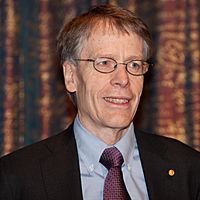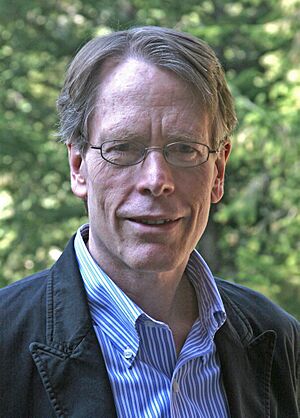Lars Peter Hansen facts for kids
Quick facts for kids
Lars Peter Hansen
|
|
|---|---|

Lars Peter Hansen (2013)
|
|
| Born | October 26, 1952 |
| Nationality | American |
| Institution | University of Chicago Carnegie Mellon University |
| Field | Macroeconomics |
| School or tradition |
Chicago School of Economics |
| Alma mater | University of Minnesota (Ph.D.) Utah State University (B.Sc.) |
| Doctoral advisor |
Christopher A. Sims |
| Doctoral students |
|
| Influences | Thomas J. Sargent, Christopher A. Sims |
| Contributions | Generalized method of moments, robust control applied to macroeconomics and asset pricing |
| Awards | Frisch Medal (with Kenneth J. Singleton), 1984 Erwin Plein Nemmers Prize in Economics, 2006 CME Group-MSRI Prize, 2008 BBVA Foundation Frontiers of Knowledge Awards, 2010 Nobel Memorial Prize in Economics, 2013 |
| Information at IDEAS / RePEc | |
Lars Peter Hansen, born on October 26, 1952, in Urbana, Illinois, is a famous American economist. He is a professor at the University of Chicago. In 2013, he won the Nobel Memorial Prize in Economics.
Hansen is well-known for his work on the generalized method of moments. This is a special way to study economic models. He also focuses on how the financial world connects with the larger economy. His research looks at how to measure risks in the economy over time.
He has received many awards for his work. One of them is the 2010 BBVA Foundation Frontiers of Knowledge Award.
Contents
Lars Peter Hansen's Life Story
Lars Peter Hansen studied at Utah State University and the University of Minnesota. He earned his Ph.D. in Economics in 1978. After that, he taught at Carnegie Mellon University.
In 1981, he moved to the University of Chicago. He is now a distinguished professor there. He is married to Grace Tsiang, and they have a son named Peter. His father, Roger Gaurth Hansen, was also a professor.
What Lars Peter Hansen Studied
Hansen is most famous for creating the generalized method of moments (GMM). This is a tool used in econometrics. Econometrics uses math and statistics to study economic data. GMM helps economists understand complex economic situations.
This method is very useful when it's hard to create a perfect model of the economy. Hansen showed how to use "moment conditions" to make good estimates. These estimates help economists understand things like labor economics and international finance.
Understanding Risk in Finance
Hansen also used GMM to study how assets are valued. Assets are things like stocks or bonds. With his colleague Ravi Jagannathan, he developed the Hansen–Jagannathan bound. This helps explain why risky investments sometimes offer surprisingly high returns. This is known as the equity premium puzzle.
He also worked with Thomas J. Sargent on a book called Robustness. This book explores how to make economic decisions when you are not sure about the future.
Risk and Uncertainty
Hansen has focused on the difference between risk and uncertainty. Risk is when you know the possible outcomes and their chances. Uncertainty is when you don't even know all the possible outcomes. He also studies "systemic risk." This is the risk that a problem in one part of the financial system could cause a collapse of the whole system. He often talks about how important it is to deal with uncertainty when making economic policies.
Groups and Awards
Hansen is a leader in several important economic groups. He was the first director of the Becker Friedman Institute for Research in Economics. He also helps lead the Macro Financial Modeling Group. This group works to improve how we understand the links between the financial world and the real economy. This work became very important after the 2008 financial crisis.
He is a member of the United States National Academy of Sciences. He has won many awards for his work. These include the Frisch Medal in 1984 and the Erwin Plein Nemmers Prize in Economics in 2006. In 2011, he received the BBVA Foundation Frontiers of Knowledge Award. This award recognized his contributions to understanding how people deal with risky situations.
Winning the Nobel Prize
On October 14, 2013, Lars Peter Hansen won the Nobel Memorial Prize in Economic Sciences. He shared the award with Eugene Fama and Robert Shiller. They were honored for their work on "empirical analysis of asset prices." This means they studied how the prices of things like stocks change over time. Hansen gave his Nobel lecture on December 8, 2013.
Selected Writings
- Hansen, L.P. and J. Borovička, "Term Structure of Uncertainty in the Macroeconomy," 2016.
- Hansen, L.P., J. Borovička and J. Scheinkman "Misspecified Recovery," 2016.
- Hansen, L.P. and Sargent, T.J. Uncertainty Within Economic Models. 2014.
- Hansen, L.P. "Uncertainty Inside and Outside Economic Models" (Nobel Lecture)
- Hansen, L.P. and Sargent, T.J. Recursive Models of Dynamic Linear Economies. 2013.
- Hansen, L.P. and Sargent, T.J. Robustness 2007.
- Hansen, L.P. "Challenges in Identifying and Measuring Systemic Risk," 2012.
- Hansen, L.P. "Generalized Methods of Moments: A Time Series Perspective," 2000.
- Hansen, L.P., (1982), "Large Sample Properties of Generalized Methods of Moments Estimators" in Econometrica, where he proposed the GMM-procedure.
See also
 In Spanish: Lars Peter Hansen para niños
In Spanish: Lars Peter Hansen para niños


